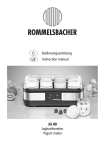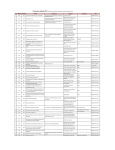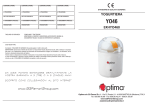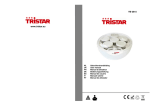Download Petra Yoghurt Maker JB 31.55
Transcript
JogurtBereiter JB 31 D Gebrauchsanweisung GB Instructions for use F Mode d’emploi I Istruzioni per l’uso D Gebrauchsanweisung Vor dem Benutzen Sicherheitshinweise Die Gebrauchsanweisung aufmerksam lesen. Sie enthält wichtige Hinweise für den Gebrauch, die Sicherheit und die Wartung des Gerätes. Sie soll sorgfältig aufbewahrt und gegebenenfalls an Nachbenutzer weitergegeben werden. Das Gerät darf nur für den vorgesehenen Zweck, gemäß dieser Gebrauchsanweisung, verwendet werden. Dieses Gerät ist dafür bestimmt, im Haushalt und ähnlichen Anwendungen verwendet zu werden, wie beispielsweise: − in Küchen für Mitarbeiter in Läden, Büros und anderen gewerblichen Bereichen; − in landwirtschaftlichen Anwesen; − von Kunden in Hotels, Motels und anderen Wohneinrichtungen; − in Frühstückspensionen. Das Gerät ist nicht für den rein gewerblichen Gebrauch bestimmt. Beim Gebrauch die Sicherheitshinweise beachten. • Die Anschlussleitung nicht über scharfe Kanten ziehen oder einklemmen, nicht herunterhängen lassen sowie vor Hitze und Öl schützen. • Das Gerät nicht auf heiße Oberflächen wie Herdplatten o. Ä. stellen und nicht in der Nähe offener Flammen betreiben. • Den Netzstecker nicht an der Leitung oder mit nassen Händen aus der Steckdose ziehen. • Dieses Gerät ist nicht dafür bestimmt, durch Personen (einschließlich Kinder) mit eingeschränkten physischen, sensorischen oder geistigen Fähigkeiten oder mangels Erfahrung und/oder mangels Wissen benutzt zu werden, es sei denn, sie werden durch eine für ihre Sicherheit zuständige Person beaufsichtigt oder erhielten von ihr Anweisungen, wie das Gerät zu benutzen ist. • Achten Sie darauf, dass Kinder keine Gelegenheit erhalten, mit dem Gerät zu spielen. • Das Gerät nicht in Betrieb nehmen bzw. sofort Netzstecker ziehen, wenn: - Gerät oder Netzkabel beschädigt ist; Technische Daten Nennspannung: 230 V 50 Hz Leistungsaufnahme: 10 W Schutzklasse: II 2 • • • • • - der Verdacht auf einen Defekt nach einem Sturz oder Ähnlichem besteht. In diesen Fällen das Gerät zur Reparatur geben. Der Netzstecker ist zu ziehen: - bei Störungen während des Betriebes - vor jeder Reinigung und Pflege - nach dem Gebrauch. Das Gerät nicht in Wasser tauchen. Bei Zweckentfremdung, falscher Bedienung oder nicht fachgerechter Reparatur wird keine Haftung für eventuelle Schäden übernommen. Ebenso sind Garantieleistungen in solchen Fällen ausgeschlossen. Das Gerät ist nicht für den gewerblichen Gebrauch bestimmt. Wenn die Anschlussleitung dieses Gerätes beschädigt wird, muss sie durch den zentralen Kundendienst des Herstellers oder eine ähnlich qualifizierte Person ersetzt werden. Durch unsachgemäße Reparaturen können erhebliche Gefahren für den Benutzer entstehen. Von der Milch zum Jogurt „Jogurt“, sagt das Lexikon, „ist eine durch Bakterien aus einge- dickter Milch erzeugte cremeartige, würzige Sauermilch; wichtiges diätetisches Nahrungsmittel”. Zur Jogurtherstellung muss die Milch „geimpft“ werden, das heißt, durch Einrühren von Milchsäurebakterien, des sogenannten Starters, wird der Reifeprozess eingeleitet. Als Starter kann entweder ein spezielles Jogurtferment oder ein handelsübliches Jogurt ohne Geschmackszusätze verwendet werden. Bei 40O C gedeihen die Bakterien am besten. H-Milch ergibt ein löffelfestes, Vollmilch ein etwas weniger festes und Magermilch ein weiches Jogurt. Gibt man etwas Milchpulver zu, wird das Jogurt fester. Das Ansetzen In den sechs Gläsern können Sie insgesamt 1 Liter Milch verarbeiten. Die Milch muss vor der Jogurtzubereitung bis kurz vor dem Kochen erhitzt werden. HMilch ist bereits hocherhitzt und homogenisiert, will man jedoch sicher gehen, sollte auch diese Milch erhitzt werden. Vor dem Impfen muss die Milch auf unter 42O C abgekühlt sein, bei höheren Temperaturen sterben die Jogurtbakterien ab, bei Tempera- turen unter 20O C werden sie nicht aktiv. Auf einen Liter Milch kommt als Starter ein Beutel Jogurtferment oder ca. 150 ml frisches Naturjogurt ohne Geschmackszusätze. Wärmebehandeltes Jogurt ist zum Ansetzen nicht geeignet, da Mikroorganismen nicht mehr vorhanden sind. Der Fettgehalt sollte dem der Milch entsprechen, sonst bleibt das Jogurt dünn. Rühren Sie den Starter in einem größeren Gefäß gut ein, er muss gleichmäßig in der Milch verteilt sein. Eine ungenügende Vermischung lässt das Joghurt unten im Glas fest werden, während es oben flüssig bleibt. Verwenden Sie nur frisches Ferment aus dem Reformhaus. Altes Ferment benötigt eine längere Reifezeit, überaltertes könnte völlig unbrauchbar sein. Fertiges Joghurt, das Sie mit Ferment zubereitet haben, können Sie beim nächsten Ansetzen wieder als Starter benutzen, indem Sie davon ein Glas auf einen Liter Milch geben. Diesen Vorgang können Sie bis zu 20 mal wiederholen - dann lässt die Wirkung nach und Sie müssen neues Ferment verwenden. Die Zubereitung Geben Sie die Milchmischung in die gründlich ausgewaschenen und heiß nachgespülten Gläser. Anschließend die Gläser mit dem Schraubdeckel verschließen und in das Gerät einsetzen. Die Reifezeit Milchansatz mit Raumtemperatur benötigt etwa 12 Stunden, bei 40O C warmer Milch verkürzt sich die Reifezeit auf 5-6 Stunden. Grundsätzlich gilt: Je länger das Jogurt reift, desto kräftiger wird dessen Geschmack. Im Zweifel lieber etwas länger reifen lassen. Stellen Sie das Gerät während der Reifezeit an einen absolut ruhigen Platz Nur dann entwickeln sich die Bakterien optimal. Das Gerät an eine Steckdose anschließen und einschalten. Die Kontrollleuchte im Schalter zeigt an, dass das Gerät heizt. Danach den Deckel so aufsetzen, dass der Einschnitt durch die Abdichtnase am Gehäuserand verschlossen wird. Der Memo-Zeiger wird auf die Uhrzeit eingestellt, bei der der Reifeprozess abgeschlossen sein wird. Einstellbeispiel: Wird der Jogurt mit 40O C warmer Milch um 7.30 Uhr angesetzt, so wird der Memo-Zeiger auf 1.00 Uhr eingestellt. Nachdem die eingestellte Uhrzeit erreicht ist, das Gerät ausschalten. Sollte das Jogurt noch nicht die gewünschte Festigkeit haben, kann die Reifezeit problemlos verlängert werden. Stellen Sie die fertigen, abgekühlten Gläser in den Kühlschrank. Das Jogurt gewinnt dann noch etwas an Festigkeit und kann den vollen Geschmack entfalten. Es hält sich dort mindestens eine Woche. Nach dem Gebrauch ist der Netzstecker zu ziehen. Wird der Deckel mit dem Einschnitt nach rechts aufgesetzt, so kann durch den dann offenen Einschnitt die Zuleitung zur Aufbewahrung ins Geräteinnere hindurchgeführt werden. Ein paar Tipps Schon in seiner natürlichen Form ist Jogurt ein bekömmliches, schmackhaftes und kalorienbzw. joulearmes Nahrungsmittel. Sie können es natürlich auch mit Früchten verfeinern. Rühren Sie diese Zusätze aber erst in das Jogurt, wenn Sie es aus dem Kühlschrank nehmen, sonst wird es zu flüssig. Sie können Jogurt mit kaltem Wasser oder Eisstücken verquirlen, dann ist es ein sehr erfrischendes Getränk für heiße Tage. Mit Jogurt vermischt sind Cornflakes, Weizenkeime oder Haferflocken für viele bekömmlicher als kalte Milch. Zusammen mit Gelatine und Früchten machen Sie ein leckeres Jogurtgelee. Als Beigabe zu Gemüse bereichert es Ihre Rohkost-Tafel. Als Zusatz zu Salaten, Suppen oder Soßen bringt es neue Geschmacksvarianten. Reinigung und Pflege Bei gezogenem Netzstecker Gerät und Deckel nur feucht abwischen. Gläser und Schraubdeckel, die spülmaschienfest sind, sollten heiß gespült werden. Garantie-Information Für unsere Geräte übernehmen wir gegenüber dem Endkunden eine 24-monatige Haltbarkeitsgarantie. Sie beginnt mit dem Kauf des Gerätes durch den Endkunden und gilt im Gebiet 3 der Bundesrepublik Deutschland. Ansprüche aus dieser Garantie sind unter Vorlage des Kaufbelegs direkt gegenüber unserem zentralen Kundendienst geltend zu machen. Von der Garantie ausgeschlossen sind Schäden durch normalen Verschleiß, unsachgemäßen Gebrauch, unterbliebene Pflege sowie Glasbruch. Der Endkunde besitzt zusätzlich zu den Ansprüchen aus dieser Garantie gesetzliche Ansprüche wegen Mängeln des Gerätes gegenüber seinem direkten Verkäufer/Händler, die durch diese Garantie nicht eingeschränkt werden. petra-electric Kundendienst Greisbacherstraße 6 D-89331 Burgau www.petra-electric.de Das Gerät entspricht den Europäischen Richtlinien 2006/95/EG, 2004/108/EG und 2005/32/EG. Dieses Produkt darf am Ende seiner Lebensdauer nicht über den normalen Haushaltsabfall entsorgt werden, sondern muss an 4 einem Sammelpunkt für das Recycling von elektrischen und elektronischen Geräten abgegeben werden. Einzelheiten erfahren Sie bei Ihrer kommunalen Verwaltung. Änderungen vorbehalten GB Instructions for use Before using Read the operating instructions attentively. It contains important hints for the use, security and maintenance of the appliance. Keep it carefully and pass it on to the next user, if necessary. The appliance should only be used for the purpose mentioned in these operating instructions. This appliance is intended for domestic use and similar applications, such as: - in staff kitchens in shops, offices and other commercial establishments; - in agricultural establishments; - by guests in hotels, motels and other accommodation facilities; - in bed-and-breakfast facilities. The appliance is not intended for purely commercial use. Be sure to follow the safety information when using the appliance. Technical Data Rated voltage: 230 V 50 Hz Power consumption: 10 watts Protection class: II Security hints • Do not pull the cord over sharp edges or jam it, do not allow it to hang down and protect it from heat and oil. • Do not put the appliance on hot surfaces, e. g. cooking plates and do not operate it near open fires. • Do not disconnect the plug by pulling at the cord or with wet hands. • This appliance is not meant to be used by persons (including children) with reduced physical, sensorial or mental capacities or in absence of the necessary experience and/or knowledge unless they are supervised by a person responsible for their safety and from whom they get instructions on how to use the appliance. • Keep out of reach from children. • If the following happens do not use the appliance or unplug it immediately: - the appliance or cord is damaged - any defect after dropping the appliance or something similar is suspected. In these cases have the appliance repaired. • Unplug the appliance: - in case of malfunctions during operation - before cleaning and maintenance - after use. • Do not immerse the appliance in water. • In case of misuse, wrong handling or incorrect repair no liability will be taken for possible damages. In such cases guarantee abligations are excluded as well. • The appliance is not designed for commercial purposes. • In case the cord of this appli ance is damaged, it has to be replaced by an authorised ser vice agent of the manufacturer or a person having similar qualifications. Substantial dan gers for the user appear from inappropriate repairs. From milk to yoghurt „Yoghurt“ says the encyclopedia „is a creamy, aromatic form of sour milk produced by certain bacteria in thickened milk; important dietary food.“ For the making of yoghurt milk has to be „inoculated“, that is by adding lactid acid bacteria, the so-called starter, the maturing process is initiated. For such a starter one can use a special yoghurt ferment or a commercial yoghurt that has no added flavor. At 40O C these bacteria thrive ideally. H-milk (specially treated milk that keeps longer) produces firm yoghurt, unskimmed milk produces less firm yoghurt and skimmed milk produces very soft yoghurt. If you add a little milk powder they will produce a firmer yoghurt. Preparations In the six jars you can process a total of 1l of milk. The milk must be heated up to the point just before boiling. H-milk is already highly heated-up and homogenized, however if you want to be sure this milk should also be heated up. Before „inoculating“ cool the milk below 42O C, a higher temperature kills the necessary yoghurt bacteria, a temperature below 20O C keeps them from becoming active. For 1l of milk you need 1 bag of yoghurt ferment or approx. 150 ml fresh naturalyoghurt without added flavor. Heat treated yoghurt can not be used as a starter because microorganisms were eliminated. The fat content should correspond to that of the milk or it will result in very runny yoghurt. Stir the starter carefully in a bigger receptacle into the milk, it must be spread evenly in the milk. If it is spread unevenly the yoghurt will be solid at the bottom and runny on the top. Only use fresh ferment from a health food shop. Old ferment requires a longer maturing process - overly old ferment can be totally useless. Yoghurt that has been made with ferment can be subsequently used as a starter. Just add one glass of it to 1l milk. 5 This can be done up to 20 times - then it loses its effect and you have to use fresh ferment. Making yoghurt Pour the prepared milk into the jars which have been rinsed in hot water. Screw the lids on and place the jars in the appliance. Maturing time The formation of milk at room temperature needs approx. 12 hours, when using warm milk, approx. 40O C, the maturing time is shortened to 5-6 hours. General rule: the longer the maturing time the more flavor the yoghurt will have. When in doubt it is better to let the yoghurt mature a little longer. Do not place the appliance on vibrating bases during the maturing process as this will prevent the necessary bacteria from forming. Plug in the appliance and turn it on - the light in the switch indicates that the appliance is heating. Place the transparent lid of the yoghurt maker in such a way that the notch in the lid is covered by the sealing prong . Set the memo - indicator to that time when the maturing process will be finished. 6 Example: If you start the maturing process with warm milk (40O C) at 7.30 h turn the memoindicator to 11 h. After the adjusted time has been reached,pull out the plug. Should you have selected the maturing time too short and the yoghurt is still runny you can extend the maturing process without problems. Place the finished and cooled jars in the refrigerator. The yoghurt can gain a little more firmness and develops its full flavor. It will keep at least one week there. After use disconnect from mains supply. If the lid is placed with the notch on the right side, the cord can easily be stored inside the appliance by pulling it through the notch. Cleaning and maintenance Disconnect from mains supply and wipe the appliance and the lid only with a damp cloth. The jars and their lids which are dishwasher-proof should be rinsed in hot water. A few hints In its natural form yoghurt is a wholesome, tasty food which is low on calories. Of course you can add fruit. When doing so add the fruit only after taking the yoghurt out of the refrigerator, otherwise it becomes runny. You can also whisk cold water or pieces of ice into it to make a very refreshing drink on hot days. Cornflakes, wheat germ or rolled oats mixed with yoghurt are more easily digested by most than when they are mixed with cold milk. Together with jelly and fruit it makes a tasty dish. Added to vegetables it enriches those foods. As an additive to salads, soups and sauces it provides new variations. For UK use only • This product is supplied with a 13 A plug conforming to BS 1363 fitted to the mains lead. If the plug is unsuitable for your socket outlets or needs to be replaced, please note the following. If the plug is a non– rewireable one, cut it from the mains lead and immediately dispose of it. Never insert it into a socket outlet as there is a very great risk of an electric shock. • The replacement of the plug at the mains lead has to be done according to the following instructions: Important: The wires in this mains lead are coloured in accordance with the following code: blue: Neutral brown: Live As the colours of the wires in the mains lead of this appliance may not correspond with the coloured markings identifying the terminals in your plug, proceed as follows: - the wire which is coloured blue must be connected to the terminal which is marked with the letter N or coloured black, - the wire which is coloured brown must be connected to the terminal which is marked with the letter L or coloured red. Do not connect any wire to the terminal which is marked with the letter E or by the earth symbol , or coloured green or green and yellow. 3.If a 13 A (BS 1363) plug is used it must be fitted with a 3 A fuse conforming to BS 1362 and be ASTA approved. If any other type of plug is used, the appliance must be protected by a 5 A fuse either in the plug or adapter or at the distribution board. If in doubt consult a qualified electrician. 4. Never use the plug without F closing the fuse cover. The appliance complies with the European directives 2006/95/EC, 2004/108/EC and 2005/32/EC. At the end of its lifetime this product must not be disposed of through the normal domestic waste, but it should be handed to an assembly point for the recycling of electrical and electronical appliances. You can inquire about details at the local administration. Subject to technical changes. Mode d’emploi Avant la mise en service Lire avec attention les recommendations et précautions à prendre pour une bonne utilisation de l’appareil. Elles contiennent des indications importantes pour l’utilisation, la sécurité et l’entretien de l’appareil. Bien conserver la notice et la remettre à tout utilisateur. Utiliser uniquement l’appareil comme indiqué dans cette notice. Cet appareil est destiné à des utilisations domestiques et comparables comme par exemple : - dans les cuisines pour les collaborateurs dans les commerces, les bureaux et d’autres domaines professionnels; - dans les domaines agricoles; - par les clients des hôtels, motels et autres services résidentiels; - dans les gîtes avec petit déjeuner. L’appareil n’est pas destiné à un usage purement commercial. Respecter les consignes de sécurité pour l’utilisation. Spécifications techniques Tension nominale: 230 V 50 Hz Puissance absorbée: 10 W Classe de protection: II Précautions d’emploi en fonction des normes de sécurité en vigueur • Ne pas tirer le cordon sur des bords tranchants, ne pas le coincer, ne pas le laisser pendre. Le protéger de la chaleur et de l’huile. • Ne pas mettre l’appareil sur des surfaces chaudes comme plaques de fourneau etc. ou à proximité d’une flamme nonprotégée. • En débranchant la fiche ne pas tirer sur le cordon, éviter les mains mouillées. • Cet appareil n’est pas prévu pour être utilisé par des personnes (inclus les enfants) ayant des facultés physiques, sensorielles ou mentales réduites ou à défaut un manque d’expérience et/ou de connaissance - sauf s’ils sont surveillés par une personne responsable de leur sécurité ou s’ils recoivent de celle-ci des instructions sur la manière d’utiliser l’appareil. • Bien veiller à ce que les enfants ne jouent pas avec cet appareil. • Ne pas mettre l’appareil en marche et le débrancher immédiatement: • • • • • - si l’appareil ou le cordon sont défectueux - s’il y a soupçon d’une anomalie après, par exemple quand l’appareil est tombé. Dans ces cas faire réparer l’appareil. Débrancher l’appareil: - en cas de perturbations en utilisant l’appareil - avant de nettoyer l’appareil - après l’utilisation. Ne pas plonger l’appareil dans l’eau. En cas d’utilisations ou réparations non-conformes, nous n’assumons aucune responsabilité pour des dommages pouvant en resulter. La garantie est également exclue dans ces cas. L’appareil n’est pas conçu pour un emploi professionnel. Dans le cas où le cordon de cet appareil est endommagé, seuls le service après-vente du fournisseur ou une personne compétente sont à même de le changer. Des réparations impropres peuvent causer de graves dangers pour l’utilisateur. 7 Du lait au yaourt Le yaourt nous apprend le dictionnaire est un lait caillé crémeux et aromatique fabriqué à partir de lait épaissi grâce à des bactéries. Cet aliment a une grande valeur nutritive. Pour fabriquer du yaourt, le lait doit être „vacciné“ c’est à dire le processus de stérilisation est amorcé en le mélangeant avec des ferments lactiques acidifiant qui agissent come catalyseur. Comme catalyseur on peut également utiliser soit un ferment lactique spécial pour yaourt soit un yaourt nature acheté chez le crémier. Les bactéries se développent mieux à 40O C. Le lait UHT donnera un yaourt ferme alors que le lait entier produira une texture moins ferme et le lait écrémé un yaourt un peu plus liquide. En ajoutant du lait en poudre, le yaourt devient plus ferme. La préparation Pour les 6 verres vous pouvez utiliser en tout un litre de lait. Avant la préparation des yaourts le lait doit être chauffé et retiré du feu juste avant ébullition. Le lait UHT a déja été chauffé et 8 homogénéisé mais pour plus de sécurité il doit être à nouveau chauffé. Avant d’être „vacciné“ le lait doit être refroidi en-dessous de 42O C. A des températures plus élevées les bactéries dépérissent et au-dessous de 20O C elles ne sont plus actives. Pour un litre de lait, on utilise comme catalyseur un sachet de ferment ou un yaourt nature frais d’environ 150 ml non aromatisé. Un yaourt pasteurisé ne convient pas comme catalyseur étant donné qu’il n’y a plus de microorganismes. Le contenu en matières grasses devra correspondre à celui du lait sinon le yaourt restera liquide. Dans un récipient suffisamment grand mélangez soigneusement le ferment avec le lait. Un mélange insuffisant a pour conséquence une mauvaise répartition: le yaourt sera ferme au fond du pot et liquide au-dessus. N’utilisez que du ferment frais acheté en pharmacie ou dans les magasins de produits naturels. Un ferment plus ancien nécessite un temps de maturation plus long et un ferment trop vieux peut se révéler totalement inefficace. Le yaourt fabriqué avec du ferment peut de nouveau être utilisé comme catalyseur en mélangeant le pot obtenu à 1 litre de lait. Vous pouvez renouveler ce procédé jusqu’à 20 fois. Ensuite le ferment devient moins efficace et il est nécessaire de le renouveler. La fabrication Versez le mélange lait-ferment dans les pots préalablement lavés et rincés à l’eau bouillante. Puis fermez les pots en vissant bien les couvercles et les poser dans l’appareil. La fermentation La durée de fermentation pour un mélange à température ambiante est d’environ 12 heures. Pour un lait chauffé à 40 °C la durée est ramenée à 5-6 heures. Règle principale: plus vous laissez fermenter le yaourt, plus son goût sera fort. En cas de doute, il vaut mieux laisser fermenter plus long- temps. Placer l’appareil à un endroit parfaitement stable car les vibrations empêchent le développent des bactéries. Branchez l’appareil sur une prise de courant et l’allumer. La lampe témoin indique que l’appareil chauffe. Placez ensuite le couvercle de manière à ce que l’encoche du couvercle s’adapte dans celle qui se trouve sur le bord de l’appareil. L’aiguille doit être positionnée sur l’heure qui indiquera la fin de la période de préparation. Une fois le temps écoulé, débranchez l’appareil. Si le yaourt n’a pas la consistance souhaitée, vous pouvez sans problème prolonger le temps de fermentation. La refrigeration Mettez les pots refroidis au réfrigérateur. Attendez au moins une heure avant de les consommer. Si vous attendez 24 heures, ils seront plus fermes. Ils peuvent ainsi être conservés pendant au moins une semaine. Après utilisation de la yaourtière, débranchez l’appareil. Il est possible de passer le câble d’alimentation à travers l’encoche en décalant le couvercle vers la droite afin de le ranger à l’intérieur de l’appareil. Nettoyage et entretien Nettoyer l’appareil avec un chiffon humide uniquement lorsque ce dernier est débranché. Seuls les pots en verre et leurs couvercles résistent au lavage en lave-vaisselle et peuvent être nettoyés à l’eau chaude. Quelques idees de dégustation Grâce à sa conception naturelle, le yaourt est un aliment sain, savoureux et peu calorique. Cet appareil est conforme aux directives européennes 2006/95/CE, 2004/108/CE et 2005/32/CE. Quand il n'est plus utilisable (fin de vie), vous ne devez pas jeter ce produit avec les ordures ménagères mais le remettre au point de recyclage des appareils électriques et électroniques le plus proche (ou déchetterie). Si vous avez besoin de détails supplémentaires, vous pouvez également vous adresser à la mairie de votre commune. Sous réserve de changements techniques. Il est possible d’y ajouter des fruits pour rendre son goût encore plus agréable. Il faut les mélanger aux yaourts dès que vous les sortez du frigidaire sinon ils seront trop liquides. Vous pouvez également battre un yaourt dans de l’eau froide ou avec des glaçons. Vous obtiendrez ainsi une boisson très rafraichîssante pour les périodes de grande chaleur. 9 I Istruzioni per l’uso Prima dell'uso Avvertenze di sicurezza Leggere attentamente le istruzioni; queste contengono informazioni importanti per l’uso, la sicurezza e la manutenzione dell’apparecchio. Conservare queste istruzioni accuratamente e, eventualmente, passarle ad altri utenti. L’apparecchio deve venire usato solo a scopi previsti da queste istruzioni. L’apparecchio è indicato per l’uso domestico e per ambiti simili di impiego, come ad esempio: - nelle cucine per dipendenti di negozi, uffici e di altri esercizi professionali; - nelle tenute agricole; - per i clienti di hotel, motel e di altre strutture abitative; - nelle pensioni bed & breakfast. La macchina non è adatta per l’uso puramente professionale. Osservare le avvertenze di sicurezza durante l'uso. • Non tirare nè incastrare il cavo elettrico in bordi taglienti, non lasciarlo penzolare e proteggerlo da fonti di calore ed olio. • Non usare l’apparecchio vicino a piani caldi, come p.e. piastre elettriche o a fiamme scoperte. • Non staccare la spina dalla presa di corrente nè con mani bagnate nè tirandone il cavo. • Il dispositivo non è destinato all'utilizzo da parte di persone (compresi bambini) dalle ridotte capacità motorie, sensoriali o psichiche o prive della necessaria esperienza e/o conoscenza, a meno che non siano sorvegliate da una persona responsabile della loro sicurezza o ricevano da queste istruzioni circa l'utilizzo del dispositivo stesso. • Prestate la massima attenzione affinchè i bambini non abbiano la possibilità di giocare col dispositivo. • Non usare l’apparecchio o staccare subito la spina quando: * l’apparecchio o il cavo siano danneggiati * in caso si sospettasse che l'apparecchio fosse difetto so dopo una caduta o altro. In questi casi portare l’appa- Dati tecnici Tensione nominale: 230 V 50 Hz Potenza assorbita: 10 W Grado di assorbimento: II 10 recchio a far riparare. • Staccare la spina dalla presa di corrente: * in caso di guasti durante l’uso * prima di ogni pulizia e manutenzione * dopo ogni uso. • Non immergere l'apparecchio in acqua. • In caso l’apparecchio venisse usato a scopi non originalmente intenzionati, in modo sbagliato o riparato da personale non autorizzato, non si assumono responsabilità per danni che ne potrebbero derivare. È pure esente da prestazioni di garanzia. • L’apparecchio non è da usare per scopi industriali. • Se il cavo di alimentazionecorrente di questo apparecchio fosse danneggiato, deve venire sostituito dal servizio-assistenza della ditta fabbricante o da una persona analogamente qualificata. Riparazioni inappropriate possono portare notevoli pericoli all'utente. Dal latte allo jogurt Lo jogurt, dice l'enciclopedia, è un latte denso che, mediante batteri, viene reso acido, sapori- to, cremoso ed è un importante alimento dietetico. Per la preparazione dello jogurt il latte deve venire "vaccinato" ciò vuol dire che, con aggiunta di fermenti lattici, così chiamati starter, dà inizio il processo di maturazione. Come starter si possono usare fermenti speciali per jogurt oppure un comune jogurt naturale senza aggiunta di sapori. Ad una temperatura di 40° i batteri maturano in modo migliore. Latte a lunga conservazione dà uno jogurt denso, latte intero meno denso e latte scremato dà uno jogurt tenero. Con l'aggiunta di latte in polvere si può rendere lo jogurt più denso. Lavorazione Nei sei vasetti di vetro può venire lavorato 1 litro di latte. Prima della preparazione dello jogurt il latte deve venire scaldato fino a poco prima della bollitura, per il latte a lunga conservazione non occorre perchè è già stato omogeneizzato, per sicurezza però può venire scaldato. Prima di " vaccinare" il latte lasciarlo raffreddare sotto i 42° perchè ad una temperatura superiore i batteri muoiono, sotto i 20° non si rendono attivi. Per ogni litro di latte è necessario come starter un pacchetto di fermenti lattici o uno jogurt fresco naturale senza aggiunta di sapori di 150 ml. Jogurt già precedentemente trattato termicamente non è adatto poichè i microorganismi non sono più esistenti. La percentuale del contenuto di grassi del latte deve corrispondere a quella dello jogurt altrimenti i nuovi jogurt restano teneri. In un recipiente capiente mescolare lo starter uniformemente nel latte.Una mescolanza non uniforme rende lo jogurt sotto spesso e sopra liquido. Usare fementi freschi acquistati in un negozio di prodotti naturali. Fermenti non freschi richiedono molto più tempo, fermenti vecchi sono completamente inusabili. Nuovi jogurt preparati con fermenti lattici possono venire poi usati come nuovi starter usandone un vasetto per un litro di latte. Questo processo può essere ripetuto fino a 20 volte poi però l'effetto diminuisce e si de vono usare nuovi fermenti. Preparazione Esempio: Un paio di consigli Ora versare quanto preparato nei vasetti lavati e risciacquati poi con acqua bollente. Chiuderli poi con il coperchio a vite e metterli nell'apparecchio. Se lo jogurt è stato preparato con latte a 40° alle ore 7.30, la lancetta di memorizzazione sarà posizionata sulle ore 11.00. Lo jogurt, già nella sua forma naturale, è un alimento digeribile, gustoso econ basso contenuto calorico. È possibile naturalmente anche raffinarlo con frutta. Mescolare però la frutta allo jogurt solamente dopo essere stato tolto dal frigorifero altrimenti diventa troppo liquido. È possibile aggiungere allo jogurt acqua fredda o sbatterlo con pezzi di ghiaccio, diventa così una bevanda rinfrescante per i giorni caldi. Jogurt mescolato a Cornflakes, fiocchi d'avena o germogli di grano è molto più digeribile del latte freddo. Unito a gelatina e frutta dà un saporito jogurtgelee. Come supplemento alle verdure arricchisce i vostri piatti di vegetali crudi. Aggiunto a insalate, zuppe o salse dà una nuova variazione di sapori. Periodo di maturazione Per latte a temperatura ambiente il tempo di maturazione è di ca. 12 ore, latte a temperatura di ca. 40° si accorcia il tempo a 5-6 ore. Normalmente più dura il tempo di maturazione e più intensivo è il sapore dello jogurt, nel dubbio lasciarlo maturare un po' più a lungo. Posizionare l'apparecchio durante il tempo di maturazione in un posto assolutamente tranquillo, solo così i fermenti si sviluppano ottimamente. Collegare l'apparecchio ad una presa di corrente ed accenderlo. La lampadina di controllo nell'interruttore indica che l’apparechio riscalda. Mettere il coperchio in modo che l'incavo si incastri nella linguetta guarnizione chiudendosi sull'orlo dell'apparecchio. La lancetta di memorizzazione viene messa sull'ora nella quale il processo di maturazione dovrà essere terminato. Spegnere l’apparecchio dopoché l’ora prefissata. In caso lo jogurt non avesse raggiunto la densità desiderata,la maturazione può venire prolungata senza problemi. Togliere i vasetti dall'apparecchio e metterli in frigorifero, la consistenza di questi diventa più densa e l'aroma diventa più intensivo. Nel frigorifero si possono tenere almeno una settimana. Finito il tutto, staccare la spina dalla presa di corrente. Mettendo il coperchio con l'incavo sul lato opposto, attraverso la parte aperta, si può introdurre il cavo elettrico e conservarlo nell'apparecchio. Pulizia e manutenzione A spina staccata, pulire l'apparecchio e il coperchio con uno straccio umido e i vasetti con i relativi coperchi , che sono adatti per la lavastoviglie, dovrebbero venire risciacquati con acqu molto calda. L’apparecchio è conforme alle direttive europee 2006/95/CE, 2004/108/CE e 2005/32/CE. Questo prodotto, quando non è più usabile, non deve venire gettato nei rifiuti casalinghi ma portato in un punto di raccolta di 11 riciclaggio per apparecchi elettrici e elettronici. Informazioni dettagliate si possono ottenere presso le relative amministrazioni comunali. Salvo cambiamenti tecnici. petra-electric Kundendienst Greisbacherstraße 6 D-89331 Burgau www.petra-electric.de Änderungen vorbehalten! – 090909 – 3838 0167 12
This document in other languages
- français: Petra JB 31.55
- Deutsch: Petra JB 31.55
- italiano: Petra JB 31.55






















